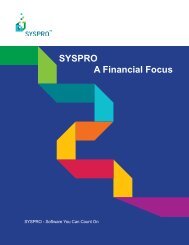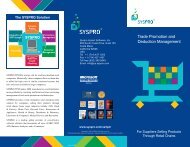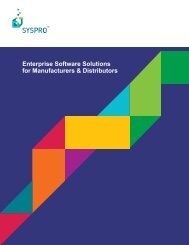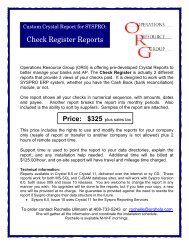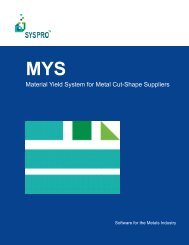Teach Yourself e.net - Syspro
Teach Yourself e.net - Syspro
Teach Yourself e.net - Syspro
Create successful ePaper yourself
Turn your PDF publications into a flip-book with our unique Google optimized e-Paper software.
XSLT Element<br />
xsl:stylesheet<br />
xsl:template<br />
xsl:text<br />
xsl:transform<br />
xsl:value-of<br />
xsl:variable<br />
xsl:when<br />
xsl:with-param<br />
Description<br />
This element must be the outermost element in an XSLT document<br />
and must contain a namespace associated with the XSLT<br />
specification and a version attribute.<br />
Defines a reusable template for producing output for nodes that<br />
match a particular pattern.<br />
Writes out the specified text to the result tree.<br />
This is used in the same manner as the xsl:stylesheet element.<br />
Writes out the value of the selected node to the result tree.<br />
This is used to declare and assign variable values that can be either<br />
local or global in scope.<br />
This is used as a child element of xsl:choose to perform multiple<br />
conditional testing. Similar to using case in a switch or Select<br />
statement.<br />
This is used in passing a parameter to a template that is called via<br />
xsl:call-template.<br />
By using these XSL attributes you will be able to transform and use the XmlOut data<br />
generated through the business objects used in your application. There is not enough space<br />
in this book to teach you all the in and outs of XSL transformations, so we would<br />
recommend that you use the basics that we have introduced in this chapter and supplement<br />
them with further reading. There are plenty of good articles and tutorials available on the<br />
inter<strong>net</strong>. For example, Chapter 17 of the XML Bible, Second Edition : XSL<br />
Transformations http://www.cafeconleche.org/books/bible2/chapters/ch17.html.<br />
6.2. Advanced ASP.NET Notes<br />
If you are already an expert in programming with ASP.NET please skip this section of the<br />
book.<br />
In this section of the chapter we deal with the use of codebehind. It may be useful for you<br />
to use an integrated development environment (IDE) like Microsoft Visual Studio .NET<br />
(or the free Express version, Visual Web Developer, which you can download from the<br />
Microsoft ASP.NET site [http://msdn.microsoft.com/vstudio/express/vwd/download/]).<br />
These programs present a drag-and-drop style interface to create the web form (.aspx)<br />
page and automatically set up codebehind (.aspx.vb or aspx.cs) controls and event<br />
handlers.<br />
6.2.1. Codebehind<br />
The use of ASP.NET allows a programmer to separate presentation (HTML) code from<br />
the application logic (in our case the C# or VB code) through the use of 'codebehind'. The<br />
6–12





